Hisako Hibi
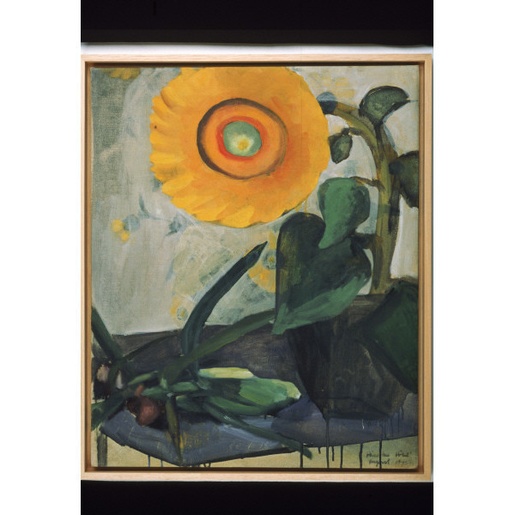
|
||
| Licensing | ||
Hisako Hibi was born in Fukui, Japan in 1907. When she was 13 years old, she came to the United States with her parents. While attending the California School of Fine Arts, now the San Francisco Art Institute, she met fellow artist and future husband, George Hibi. During World War II, Hisako, along with her husband and two children, were incarcerated in Tanforan Assembly Center and then the Topaz concentration camp in Utah. While at camp, Hisako and George stayed involved with art in the camp school system. This collection features some of the paintings that Hisako did while incarcerated. Her art depicts the daily lives and activities of those incarcerated during World War II. To see the rest of Hisako's paintings, please visit the Japanese American National Museum website. Copyright is held by the Japanese American National Museum. Short-term educational use with limited circulation is permitted. For all other uses, please contact the Hirasaki National Resource Center at the Japanese American National Museum hnrc@janm.org
Slides in this album |
|
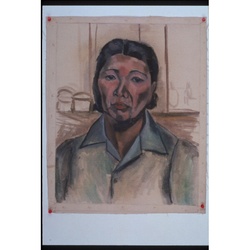
|
Hisako Hibi - "Study for a self-portrait"Hisako painted this picture of herself. In it, she has on a collared shirt, and sits among what looks like a kitchen. She doesn't look enthused, probably due to the fact that she is imprisoned in a concentration camp. |

|
Hisako Hibi - "Tanforan Assembly Center"Hisako went to the Tanforan Assembly Center before going to Topaz concentration camp. The assembly center used to be a racetrack. And, as you can see, the buildings in the picture are huddled together inside this racetrack. The closeness of the buildings communicates the feeling of being cramped and uncomfortable, … |
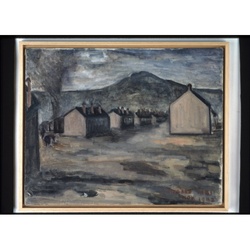
|
Hisako HIbi - "Topaz, Utah"This rather desolate and barren looking painting reflects what Topaz concentration camp was like. Families were housed in one room barracks, which had walls that were very thin. These walls would not have done much to protect them from the grayness and cold temperatures outside. |

|
Hisako HIbi - "Topaz High Under Construction"When the prisoners first arrived at Topaz concentration camp, many facilities were not yet complete, including Topaz High School. |
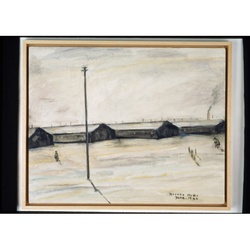
|
Hisako Hibi - "White Heat"This is a representation of a harsh Utah winter, which was very different from the San Francisco weather that Hisako and her family were accustomed to. |

|
Hisako Hibi - "Coal"At the concentration camps, families were placed into one bedroom "apartments." These apartments were furnished with a pot belly stove, with which the families were supposed to keep warm during the harsh winters. To get the coal to burn in their stoves, the people had to haul it themselves from … |
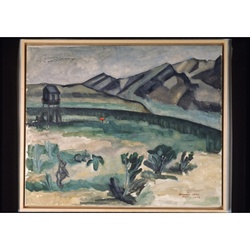
|
Hisako Hibi - "Limitation"This painting represents how limited the people in the concentration camps were. They were not allowed beyond or too close to the barbed wire fences shown here. The picture is a reminder of what the Japanese Americans during World War II had to endure in the concentration camps. |
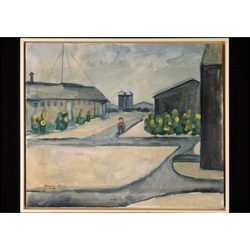
|
Hisako Hibi - "Water tank"Sunflowers were one of the only types of flowers that could be grown in the desert climate of Utah. This painting is evidence of the effort made by the prisoners to beautify their otherwise desolate and bleak environment. They did so through such things as gardens and gravel paths/roads, as … |

|
Hisako Hibi - "Topaz Farm Products"As mentioned previously, the people at Topaz concentration camp did what they could to beautify their environments. These farm products are a result of the Topaz agricultural department, which was created as a way to pass the time at camp. The produce from these gardens helped supplement the much less … |

|
Hisako Hibi - "A cold day"The Topaz concentration camp could get very cold in the winter time. This picure highlights the black smoke exiting the chimneys of the barracks. This smoke is from the burning coal, the one source of fuel for warmth in the concentration camps. |
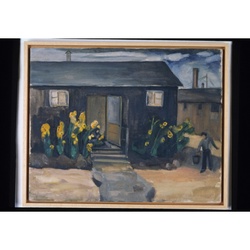
|
Hisako Hibi - "In front of my apt."Again, Hisako included sunflowers in her painting to show how possible it was grow something so beautiful in such a desolate environment. This "home" looks pleasing to the eye. However, we must not forget that these rooms were very small, and did not offer much protection from outside elements such … |

|
Hisako Hibi - "Shower, latrine and laundry building"The showers, latrines and laundry facilities were often in the same building, as is suggested here. Often times, people would stay up until very late to take a shower in order to avoid any embarrassement or shame.
Hisako Hibi - "Shower, latrine and laundry building" |
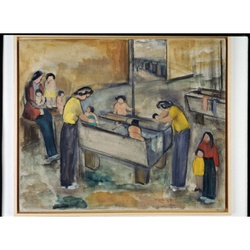
|
Hisako Hibi - "Laundry Room"Laundry rooms and latrines were all communal. In addition, they were poorly equipped and maintained. The bathroom only had four bathtubs, so women would wash their young children in a laundry room sink, as is depicted here. |

|
Hisako Hibi - "A letter"This painting is rare, for Hisako did not often create art of images and things inside the barracks. This painting includes all that would have been inside of a typical room. It includes the pot belly stove, which was powered by coal, laundry hanging from the wall, a broom, etc. … |
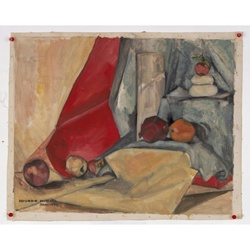
|
Hisako Hibi - "New Year's Mochi"Hisako's first New Year at Topaz concentration camp did not include mochi, which is traditionally made and eaten in the Japanese culture during New Year celebrations. So, Hisako painted this picture of mochi, a pomegranate, an orange and apples. |
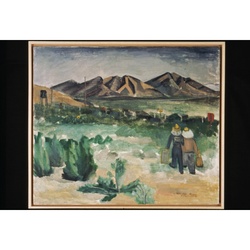
|
Hisako Hibi - "Treasure hunting"After some time, the prisoners were allowed to go out on small, monitered excursions outside of the barbed wire boundaries. On these trips, some people found arrowheads belonging to native american tribes that had once inhabited the area, topaz, and other "treasures." We must remember that although they were allowed … |
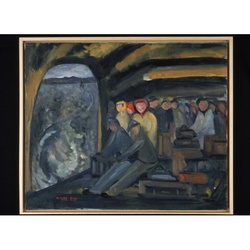
|
Hisako Hibi - "Shopping to Delta"The people of Topaz concentration camp were eventually allowed to go to Delta, the nearest town to Topaz, to shop and purchase necessary items. However, only one person per block per week was allowed to go, and the trucks they were transported in were covered entirely, preventing anybody from seeing … |
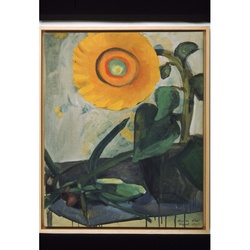
|
Hisako Hibi - "Topaz flower-sunflower and corn"I feel this picture is rightfully placed at the end of this collection, for multiple reasons. First, Hisako was very fond of this flower, the sunflower, because regardless of the harsh weather conditions at Topaz, it grew and it flourished. Perhaps she was so fond of these characteristics because she … |
 eishida
eishida
 UCLA Nikkei Student Union Culture Night 2008
UCLA Nikkei Student Union Culture Night 2008 The Sculpture of Ruth Asawa: Contours in the Air - Audio Tour
The Sculpture of Ruth Asawa: Contours in the Air - Audio Tour Wakatay Restaurant-Peruvian Nikkei Cuisine
Wakatay Restaurant-Peruvian Nikkei Cuisine 2007 Gardena Buddhist Church Obon
2007 Gardena Buddhist Church Obon Frank Kikuchi
Frank Kikuchi Hisako Hibi
Hisako Hibi San Jose Taiko and CAVA - 1st and Central Summer Concerts 2007
San Jose Taiko and CAVA - 1st and Central Summer Concerts 2007 2007 Higashi Honganji Buddhist Temple Obon
2007 Higashi Honganji Buddhist Temple Obon Landscaping America: Beyond the Japanese Garden - Timeline
Landscaping America: Beyond the Japanese Garden - Timeline Jack Iwata Collection
Jack Iwata Collection
 Journal feed
Journal feed
